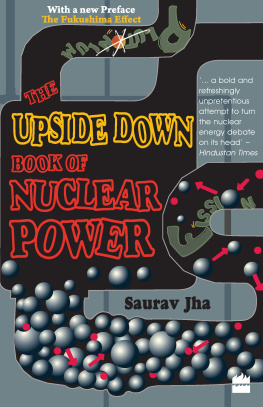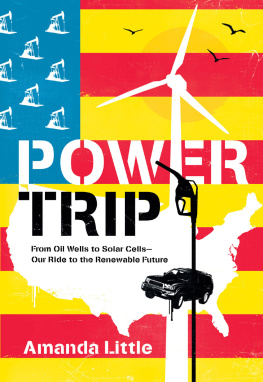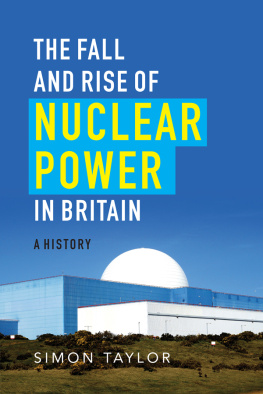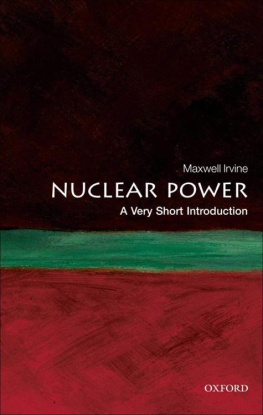LIGHTS ON!
LIGHTS ON!
THE SCIENCE OF POWER GENERATION
MARK DENNY

2013 The Johns Hopkins University Press
All rights reserved. Published 2013
Printed in the United States of America on acid-free paper
2 4 6 8 9 7 5 3 1
The Johns Hopkins University Press
2715 North Charles Street
Baltimore, Maryland 21218-4363
www.press.jhu.edu
Library of Congress Cataloging-in-Publication Data
Denny, Mark, 1953
Lights on! : the science of power generation / by Mark Denny.
pages cm
Includes bibliographical references and index.
ISBN-13: 978-1-4214-0995-5 (hardcover : alk. paper)
ISBN-10: 1-4214-0995-X (hardcover : alk. paper)
ISBN-13: 978-1-4214-0996-2 (pbk. : alk. paper)
ISBN-10: 1-4214-0996-8 (pbk. : alk. paper)
ISBN-13: 978-1-4214-0997-9 (electronic)
ISBN-10: 1-4214-0997-6 (electronic)
1. Energy conversion. 2. Energy storage. 3. Renewable energy sources.
4. Power resources. I. Title.
TK1041.D46 2013
621.31dc23
2012045324
A catalog record for this book is available from the British Library.
Special discounts are available for bulk purchases of this book. For more information,
please contact Special Sales at 410-516-6936 or specialsales@press.jhu.edu.
The Johns Hopkins University Press uses environmentally friendly book
materials, including recycled text paper that is composed of at least
30 percent post-consumer waste, whenever possible.
ACKNOWLEDGMENTS
Thanks to Vincent Burke and Jennifer Malat at the Johns Hopkins University Press for ensuring the smooth transition of this book from conception to production. Thanks to Carolyn Moser, once again, for her expert copy-editing. I am grateful to Dr. Charlotte Geier for permission to reproduce .
Two oil experts generously contributed their time and expertise to answering my questions on that important subject; I am much obliged to Dr. Alan McFadzean and Dr. Peter Ward for their contributions. I thank Dr. Carolyn Mattick for providing me with a copy of her paper on the history of energy production.
INTRODUCTION
This book is about energy and powerthe kind that we need to heat our houses and light our streets, to get us from A to B, and to drive our industries. Power generation is a relatively recent problem historically because the human need for power was minimal until the Industrial Revolution. Nowadays it is, and is rightly seen to be, a formidable and perhaps overwhelming problem that we need to address, for the benefit of future generations as well as ourselves. In this book, I look into the different ways in which it is possible to generate powerto tap into one or another source of energy that is locked up somewhere, releasing it in a controlled and usable manner.
My approach is that of a scientist and engineer, not a politician or businessman. I am not inclined to excited hyperbole, though it seems to me that some people on the committed environmentalist wing of the current debate about energy sources do lean that way. Some folks at the other end of the spectrum are equally irrational, inclined toward equal exaggeration though usually less shrill. The result has been a heated debate (almost a punsorry) that spreads confusion and perhaps contributes to a regrettable apathy among the general public.
My aim in writing this book is to provide a readable exposition of the science and engineering of power generation, without raising your blood pressure too much. That is to say, I would be happy if you become engaged with the subject and (dare I say) energized as you digest the meat of this book, but I will not be expounding extreme or one-sided political views, or telling you what to do or think. I will be providing brain fodder for you to ruminate upon by presenting you with the story of our search for energy sources, the science behind each of the power generation technologies, and the facts of historical development. No politicsor, more realistically, no political agenda. (It is difficult to make a statement about our energy future without being political.)
Before saying more about our subject, let me provide you with a flavor of the approach to it that is adopted throughout this book. Here is a scientist-cum-engineers quick glance at a much-discussed, promising and benign source of power, and its potential for solving the needs of humankind.
Humanity currently consumes a total annual average of 1420 terawatts (TW) of power. A terawatt is 1,000 gigawatts (GW); a gigawatt is 1,000 megawatts (MW); a megawatt is 1,000 kilowatts (kW). Switching on an electric kettle consumes a couple of kilowatts, and your electricity bill is likely expressed in kilowatts, or in kilowatt-hours (kWh), the energy equivalent of this ubiquitous power unit.
Here is a quick, back-of-the-envelope calculation to put into perspective a few conceptions that you might entertain concerning power generation. Most of our power and heat, and all of our light, come from a single giant thermonuclear power plant (a fusion reactor) in the sky. Our sun bathes the earth with electromagnetic waves, mostly in the form of visible light or invisible infrared radiation (heat). The amount of solar power that reaches our upper atmosphere is 1.35 kW/m2; multiplying up by the cross-sectional area of the earth gives us about 172,000 TW. That is, the total amount of solar radiation that bathes the upper atmosphere of our planet exceeds our total power consumption by a factor of 8,600 (assuming the upper figure of 20 TW for current world consumption). Given this elementary fact, isnt it obvious that all our power source problems will go away if only we build up a massive infrastructure of solar power plants?
Not at allalthough, as we will see in
Lets keep going with this rough-and-ready look at solar power potential. The efficiency of a solar power plant is less than 1%. (Only a small percentage of the land area of a power plant is covered by solar panels, and the solar panels convert only a small fraction of the sunlight they receive into electricity. Interestingly, 1% is also about the efficiency of a photosynthesizing biological plant, converting solar energy into chemical energy.) This figure was gleaned from two of the worlds largest solar power plants, both of which are in regions of very high insolation, or ambient sunlight levels. Let us agree on an average efficiency, for solar power plants all over the world, of 1%. Thus, our factor of 860 is reduced to 8.6. This figure shows (doesnt it?) that we dont need to bother with other, dirtier sources of power such as biofuels or nuclear plants: covering the world with solar power plants will provide us with more than eight times our annual power requirement.
Not so fast. We cannot give over the whole surface of our planet to solar power plants. Most of the surface is ocean, and we need most of the land for other things, like cities and roads and agriculture and forests. We cannot realistically expect more than, say, 1% of our planet to be festooned with solar power plants, no matter how desperate we become for electrical power. Consequently, we obtain a value of about 8%give or takefor the maximum possible contribution to our power needs from the sun. Further, the 20 TW figure for the power needs of our species is likely to rise significantly in the future, as the population rises and as Third World nations industrialize (see the chart). More people means more pressure for land, which is likely to depress my optimistic guess that 1% of the earths surface (i.e., 3% of the land surfaceabout 1.7 million square miles) could be taken up by solar power plants.
Next page











